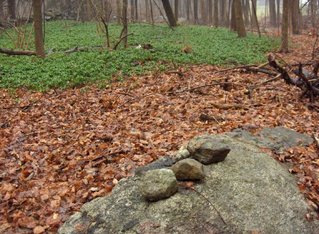 In the background is a large patch of Pachysandra - a popular ground cover used by Europeans as a planting around the house. In this picture it is a very safe assumption that there was a colonial -or later- house with a Pachysandra planting around it and, long since, the Pachysandra has grown and spread out to form this patch we see today. On the other hand, in the foreground, is a rock pile which looks delicate and new. Could the pile be older than the Pachysandra? No way. In fact this part of the woods (eastern foot of Robbins Hill in Chelmsford) looks to be where the reported lime quarrying must have taken place - it is a part of the hill that has been much disturbed. Such a delicate pile would not have survived the coming and going of many people. But there it is.
In the background is a large patch of Pachysandra - a popular ground cover used by Europeans as a planting around the house. In this picture it is a very safe assumption that there was a colonial -or later- house with a Pachysandra planting around it and, long since, the Pachysandra has grown and spread out to form this patch we see today. On the other hand, in the foreground, is a rock pile which looks delicate and new. Could the pile be older than the Pachysandra? No way. In fact this part of the woods (eastern foot of Robbins Hill in Chelmsford) looks to be where the reported lime quarrying must have taken place - it is a part of the hill that has been much disturbed. Such a delicate pile would not have survived the coming and going of many people. But there it is.Why is it so hard to believe this pile is recent and the Pachysandra is old? Yet that is obviously the case. I emphasize this because it is the story, not simply part of the story-telling. It is very hard to accept that the Indians were and are here and were and are performing ceremonies in these our European backyards.
No comments :
Post a Comment